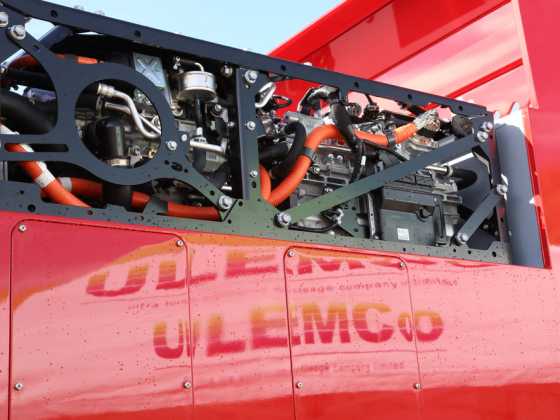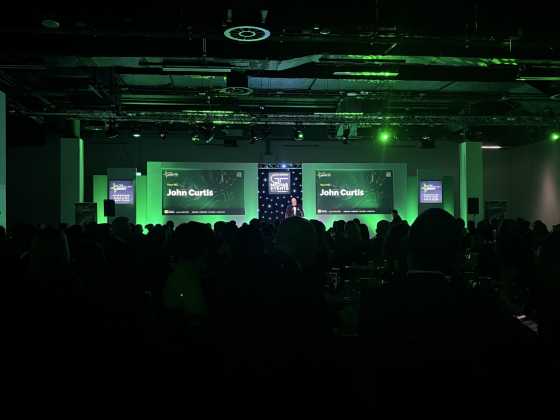Expert Panel: SME Decarbonisation

Many small businesses have been hit hard by the cost of living and energy crisis, and as a result, are delaying the move to zero-emission vehicles due to their high upfront costs. We ask our expert panellists – Richard Parker, Steve Beadle and Matt Waller – for advice on how SMEs can cost-effectively make the switch, and where to go for support
Watch our panelists speak about these issues here.
During the current cost-of-living crisis, with high energy bills and operating costs, many small and medium-sized enterprises (SMEs) may be putting off the move to zero emission vehicles due to their high upfront costs, as well as the investment that may be needed for charging infrastructure.
Recent research from Bridgestone and Webfleet backs this. It found that over three quarters (76 per cent) of commercial fleets are postponing their fleet electrification plans due to mounting cost pressures.
However, delaying decarbonisation plans can risk longer term issues, believes Richard Parker, Webfleet UK’s EV Lead at Bridgestone Mobility Solutions. Richard explains: “Cutting capital spend in this area is a case of kicking the can down the road – and this can risk compromising longer-term profitability.
“Financial and sustainability business objectives tend to be mutually inclusive, and a cost-benefit analysis that looks beyond short-term cost management is recommended.
“Electric vehicle fleet registrations are continuing to rise rapidly, and there are strong reasons for this, beyond the impending sales ban for new petrol and diesel cars and vans.
“Despite the higher upfront expense – along with soaring energy prices pushing up day-to-day running expenditure – the whole-life cost of operating petrol or diesel equivalents, in most cases, remains greater.
“Establishing the business case is vital, and telematics solutions can play an important role here by generating data insights to simplify comparisons between petrol and diesel vehicle running costs and real-world EV performance. EVs may not be right, at this point in time, for all businesses and all use cases, but planning reports will point to which vehicle fleets can be cost-effectively switched to EV alternatives.”
Funding methods
Steve Beadle, head of 0Zone at The Grosvenor Group, advises that organisations give careful thought to their funding method before ordering electric vehicles. He says: “Offering your drivers a salary sacrifice scheme is a particularly strong option at the moment due to the very low benefit-in-kind (BIK) tax for ultra-low emission and electric vehicles. It means employees can drive an electric car for up to 40 per cent less with salary sacrifice compared to a personal lease, with advantages for your business too. Grosvenor’s offering is risk-free as it comes with protection against employees leaving the company, or going on extended sick or maternity/paternity leave.
“If you own your vehicles, and do not wish to pursue the salary sacrifice option, then contract hire has particular benefits for companies who are concerned about the cost of living crisis. As contract hire is a fixed cost, the risks of relatively ‘unknown’ future re-sale values and maintenance for electric vehicles sit with the leasing company giving you peace of mind and clear budgeting when embarking on EVs for the first time.”
SMEs should not to be lured into a false economy of thinking EVs are more expensive due to their higher purchase prices, because their total cost of ownership is lower, Steve adds. “Let’s take, for example, a Skoda Octavia Diesel Estate 2.0 TDI 200 vRS 5Dr DSG,” says Steve. “This is a diesel car with a P11D value of £36,555. Its electric equivalent is the Skoda Enyaq IV Estate 150kW 80 Loft 82kWh 5Dr Auto which has a P11D value of £42,870.
“At first sight, the electric model looks expensive and it would be easy to assume that, at just over £6,000 more, the diesel is better value. However, the whole life cost takes into account factors such as running costs, maintenance, tax, fuel/charge and future resale value and shows that the electric model is £91.56 per month less than it’s diesel counterpart, meaning that it is £4,394.71 cheaper overall during a four year period as a company car.”
A long term plan
Agreeing that a total cost of ownership approach is best fitted for electric vehicles, Matt Waller, EV solutions director at FLEETCOR, the parent company of Allstar, says: “The business case is inevitably a long term plan as EVs generally offer lower ‘fuel’ costs, reduced maintenance bills, and zero or discounted car tax, and are eligible for government grants. As well as lower running costs, the environmental impacts are also significantly reduced, helping companies towards those crucial emissions targets.”
But even with this knowledge, Matt understands that the transition is not easy and there are hurdles to overcome: “We often find that fleets underestimate the cultural change of the EV transition for drivers,” comments Matt. “The switch to EVs is a massive undertaking, from ensuring the technology is up to standard and can effectively replace traditionally fuelled vehicles, to changing mindsets, and ensuring the infrastructure is available to support both private and business users without leaving them stranded or out of pocket.
“These have all been barriers to entry for new EV users, but with the government’s deadline to stopping the sale of new petrol and diesel vehicles rapidly approaching, we’re seeing many businesses are increasingly making the move. There are fleets that we’ve worked with that have been successful already in kicking-off the transition, and the key has been taking it in small incremental steps and accepting a mixed fleet in the short term.”
“We’ve made it our mission to create not only one of the biggest EV networks but one that provides a wide range of charging options to create inclusivity for those drivers that do not have the ability to recharge their vehicles at home. All of these products accompany our great set of fuelling solutions to enable customers to benefit from a single provider, single invoice and in the vast majority of cases, with the Allstar One Electric, a single card,” Matt adds.
A net-zero strategy
Research from Lloyds Banks shows that 77 per cent of small businesses do not have a net zero strategy in place, and 34 per cent said this was down to a lack of knowledge. To help fleets before embarking on their net zero plans, where can SMEs go to get support and information to fill this knowledge gap?
Steve Beadle from The Grosvenor Group recommends that businesses talk to someone impartial and lay out their individual requirements. He explains: “Every company is different in terms of the vehicles they require, the geographical areas they operate in, how the vehicles are used, the mileages driven, the mix between cars and commercial vehicles, the ability to install workplace charging, availability of public charging points, the ability for employees to charge at home – and so the list goes on.
“It is therefore always best to talk to someone impartial who can understand your business and offer relevant advice that can be implemented. At Grosvenor Leasing, our 0Zone team has been helping companies large and small with their net zero strategies for six years and have won multiple awards for their guidance. As the UK’s largest privately-owned contract hire and fleet management specialist, we are not tied to any particular funder or vehicle manufacturer which is why we can offer truly objective support.
“We are always happy to speak to SMEs and answer any of their questions with no obligation to use our services, as we see ourselves playing an important role in helping to drive the green agenda with this complimentary service. We can also put SMEs in touch with other businesses that we have helped to hear about their net zero journey.”
Utilise resources
FLEETCOR’s Matt Waller suggests other places that SMEs can look for support when implementing decarbonisation plans. He says: “Developing a sustainability strategy may seem daunting for companies at the smaller end of the scale with limited budget and resources. However, there are many resources available to help businesses get started. The government’s SME Energy Efficiency Scheme, for example, provides free energy efficiency assessments and funding towards energy-saving equipment for SMEs. There are also a growing number of sustainability consultancies that can help businesses develop and implement a sustainability strategy.
“Implementing a strategy doesn’t have to be expensive, but your business will get out what it puts in. Some smaller companies may need staff to take time out of their regular duties to put together a strategy as best they can without training, others may hire consultancies to help them through the transition, and larger companies might be able to hire trained staff to form a dedicated sustainability team.”
Tapping into the expertise of partners and suppliers can also help smaller businesses navigate the decarbonisation task, believes Matt. He says: “SMEs should also be speaking to their current service providers across fleet management, fuelling, OEMs, service maintenance and repair to understand the opportunities they have to execute on “low hanging fruit”. The road to net zero can only be navigated through a strong network of proficient partners that have experience in helping businesses from the large corporate entities right down to the one or two person operations.”
Gaining support
Richard Parker from Webfleet points towards the “growing ecosystem of advice” when it comes to transitioning to zero emission vehicles, including support and consultancy groups, online resources, dedicated forums and events.
“Here at Bridgestone Mobility Solutions, for example, we are committed to helping fleets achieve their sustainability ambitions. Alongside game-changing tech innovations, we have published a wide range of specialist guides on decarbonisation and electrification, designed to inform, educate and inspire,” says Richard.
“What’s more, as a provider of fleet management solutions that can help ease and cost-optimise EV adoption, we offer consultancy support to ensure these are implemented and utilised by businesses in the most appropriate and effective way. Our support includes introductions to specialist services from partner organisations that can help facilitate the transition.
“Elsewhere, extensive information and advice can be found via organisations such as The Energy Saving Trust, Zemo Partnership and the government’s Office for Zero Emission Vehicles,” Richard adds.
Charging infrastructure
For companies buying electric vehicles, consideration must be given to where the vehicles will be charged. So how can this process be kicked off?
Steve Beadle from Grosvenor Group advises that it’s worth conducting a brief feasibility survey with employees before you plan out your approach to charging.
Steve expands: “By asking employees if they are able, and willing, to have a home charger installed will help identify those who are going to be able to charge at home versus those who will be reliant on either a workplace charger and/or the public charging network.
“For those reliant on workplace and public charging, where are they located, where do they travel and will it be feasible for them to run a fully electric vehicle.
“This will also begin to identify likely numbers of drivers who may wish to use a workplace charger so that you can plan the required numbers of chargers, if you have the ability to install them.
“For some small to medium sized businesses, the ability to install workplace charging simply isn’t an option. Either they don’t have the car parking space, or they are in shared offices with an allocation of parking bays and the decision doesn’t rest with them. In these scenarios, we go back to the feasibility survey because if drivers cannot have a home charger installed, and live/operate in an area with a limited public charging infrastructure then maybe a fully electric car isn’t yet right for them and they need to look at PHEVs or ULEVs.
“However in doing this research will help you pinpoint which drivers can drive a fully electric vehicle and what charging infrastructure can best support them.”
It is also worth thinking about ways to financially support workers to install a chargepoint at home. Steve says: “Where home charging is feasible, now that the installation grant has been removed, one way to support drivers financially in getting their home charger installed is via a salary sacrifice scheme, particularly where salary sacrifice is your chosen method for encouraging drivers into EVs. We can also include the cost of charge points within a contract hire lease.”
It is also important to get data on how workplace chargers are being used and paid for. Steve says: “For those companies that do have workplace chargers, most are allowing drivers to plug in and use them for free, with no record being kept of who is using it and how much its costing per driver.”
“Companies should now be looking to upgrade their existing chargers to Smart Chargers, or installing new Smart Chargers, that can provide data on who is plugged in and what charge they have used so that some form or payment scheme can be put in place.”
A future proofed strategy
Steve Beadle highlights other charging infrastructure considerations: “Businesses also need to think about how many charge points they can have on site, the level of investment they need to budget for and whether the existing back office electrics can cope. For example, if you are going to charge above 22Kw you need a tethered charge point, which is a significant investment and depending on the demand for workplace charging may, or may not, be a viable spend.
“It’s quite a dilemma, because there’s little point in having slow chargers - otherwise drivers will plug in and take hours to charge which means the facility won’t be able to adequately serve all EV drivers (employees and visitors).
“It comes down to the fact that a ‘future-proofed’ charging strategy is needed, and Grosvenor’s 0Zone team can offer advice and support to find the best solution.”
Operational requirements
All companies are different and some may find it easier than others to switch over to electric vehicles. But operational requirements must be assessed before changes are made. Matt Waller from FLEETCOR comments: “Going electric isn’t as simple as swapping every ICE vehicle for an EV – although it can be for some. A company that has a small fleet of company cars for salespeople and executives can (in principle) simply change their existing vehicles to EVs as needed and use EV charging cards so that their drivers could use public charge points.
“Other companies will have to do more work to prepare. A company with large numbers of vehicles that see a lot of use – a delivery company for instance – may have to take a look at their operations and make some changes. For example, EVs still take significantly longer to recharge (on the lower end charge points) than their ICE vehicle counterparts do to refuel at a traditional pump. This means that it may be necessary to stagger shift patterns or charging times to help ensure vehicles aren’t all arriving back on site at the same time, or it may be necessary to find ways for vehicles to be charged outside of work hours (such as at home or at work).
“Many companies allow their drivers to take their vehicles home overnight and by charging at home, overnight when the vehicle isn’t in use, they are often more convenient for drivers and their companies. It is important to consider how you can enable home charging when every driver in your company has unique personal circumstances which might make it difficult and will require companies to be flexible and empathetic.
“Finally, some companies, principally those larger ones with more on-site space, also consider what charging infrastructure they need at their premises and how they can reduce the cost of this by opening it up to employees and customers. The alternative for smaller companies might be a reduced number of charge points on site but the same principle of providing multiple options for their employees,” adds Matt Waller.
Connected EV data
Richard Parker from Webfleet says that data can give insight into the above points and form an effective EV strategy. He says: “Ensuring electric vehicles are charged to meet the requirements of next day operation, that they can be operated in a way that minimises downtime, optimises business productivity and maximises range is crucial to their successful adoption.
“From the outset, consideration should be given to charging infrastructure and availability. Public charge point availability can be a problem in rural areas, for example, while charging space can also be limited at motorway services, heightening range anxiety and complicating journey planning.
“Connected EV data can help shape the creation of effective fleet charging strategies. These insights will help businesses determine where their vehicles spend the most time and will reveal their typical mileage and dwell time. This will be unique to every fleet but will signpost whether vehicles will need to use home, office or public charging infrastructure – or a combination of all three.
“In some cases, charging availability at employees’ homes may be limited, but fleets should bear in mind that even the cheapest public chargers will be considerably more expensive than home charging, while the most expensive can prove more costly than petrol or diesel.
“Where charging stations are required at business premises, telematics reports can paint a detailed picture of driver working patterns, signalling how many will be needed, whether standard chargers are appropriate, or if more expensive rapid chargers are necessary. In some cases, a single charger might serve multiple vehicles and rapid chargers may only be needed as back-up.”
Look beyond business travel
Aside from zero emission vehicles, are their other ways small firms reduce the emissions from their transport operations?
Steve Beadle from The Grosvenor Group says: “Within the ‘scope’ of a small firm’s own business travel, there are of course ways to drive down emissions through the continuation of hybrid working, encouragement of online meetings, car sharing, offering priority workplace car parking to drivers of electric vehicles, and offering mobility as a solution Apps to encourage more varied ways of getting from A to B using public transport.
“However, often businesses with a relatively small number of vehicles, and in particular those who are already providing ULEVS and EVs, believe they have done everything in their power to reduce the emissions generated by their transport operations.
“However, most businesses rely on third party suppliers to transport and deliver their goods, or provide outsourced services and, while the company itself may have driven down their own emissions, their business can still be contributing to high carbon emissions if their supply chain is not working to the same green agenda.
“My suggestion is therefore to look beyond your own business travel and start to challenge the emissions of your supply chain in order to ensure that your overall business activity is a net zero as possible.”
Cutting miles and more planning
Richard Parker from Webfleet says that cutting miles from operational journeys, or improving the mpg of vehicles, will help reduce an SME’s carbon footprint. “Efficient job allocation, journey planning and smart routing are critical to reducing fuel consumption, with every litre of fuel saved equating to more than 2kg of CO2,” comments Richard.
“Vehicle mpg, meanwhile, can be affected by a wide range of factors, from payload and tyre choice to maintenance processes. It is the driver, however, that arguably has the greatest impact.
“Fuel consumption can increase dramatically with incidents of idling, speeding, harsh cornering, braking, and shifting gear at the wrong time.
“Fleet management solutions deliver actionable insights in these areas to help profile individual drivers or entire fleets, and these can then be used to support continuous performance improvement programmes. What’s more, drivers can be empowered with real time information fed to their in-vehicle navigation devices.”
Reviewing how your organisation operates can not only help with emission reduction, it can also improve driver wellbeing, says Richard. He explains “To boost engagement with improvement initiatives, particularly in the current climate, companies should be mindful of the benefits of fostering a positive working environment.
“Webfleet research has revealed that more than three quarters (76 per cent) of fleet operators believe work pressures facing drivers are intensifying in the wake of the ‘cost of business’ crisis. A similar number (75 per cent) also believe the cost-of-living crisis is negatively impacting their mental health.
“Almost three-quarters (74 per cent) went on to admit that they need to review their current systems and processes to help alleviate workforce stress – an important eco-driving influencer.”
Energy and offsetting
FLEETCOR’s Matt Waller signposts other areas an SME can look at to decarbonise its entire operations. He says: “In addition to switching to EVs, there are many other ways that businesses can improve their sustainability credentials. This may include reducing energy consumption through energy-efficient equipment and building management systems, as well as implementing waste reduction measures. Larger companies can also consider offsetting their carbon emissions through schemes such as tree planting or renewable energy projects.
“Some other ways that small firms can reduce the emissions from their transport operations include shared mobility, reducing the number of cars on the road and saving fuel costs and parking fees.
“Avoid unnecessary business travel by using video conferencing tools instead of face-to-face meetings, saving time and money as well as emissions.
“Implement a fleet management or telematics system that optimises routes, reduces mileage, monitors fuel consumption and emissions, and encourages eco-driving behaviour among drivers. This can help you save fuel, reduce maintenance costs and improve safety.”
What is clear from the advice of our expert panel, smaller organisations have a wealth of support when it comes to the often daunting task of switching their transport operations to zero-emission alternatives.
About our expert panelists
Matt Waller, EV solutions director, FLEETCOR - parent company of Allstar
Matt is responsible for solutions for electric vehicle charging both on-the-road and at home across the UK and wider Europe. He is passionate about the future of e-mobility, with a focus on layering existing services with new innovations such as connected vehicle technology, as well as an overall aim of driving acceleration in the UK’s transition to EVs and alternative fuels. Prior to joining FLEETCOR, Matt was Head of Mobility Solutions at IMS, leading activities across vehicle data, fleet management and stolen vehicle recovery. He has also held multiple product-facing roles at Jaguar Land Rover, with successes including the launch of InControl telematics, delivery of the all-electric Jaguar I-Pace and the development of the award-winning connectivity technology in the new Land Rover Defender.
Steve Beadle, head of 0Zone, The Grosvenor Group
Steve Beadle is head of 0Zone, the Grosvenor Group’s innovative and market leading solution to help companies navigate their way smoothly towards ultra-low emission and electric vehicles. With extensive experience of helping companies make the smooth transition to ultra-low emission and electric vehicles, he offers a perfect balance between how fleets can drive down their emissions and the implications of policy setting. Steve joined the Grosvenor Group in 2012, and is well-known for his clear and inciteful advice for companies with car and light commercial vehicle fleets looking towards their zero emission futures.
Richard Parker, electric vehicle lead, Webfleet, part of Bridgestone
Webfleet UK and Ireland’s EV lead, Richard Parker, has 23 years of experience in the fleet industry. In the last seven years, Richard has committed to developing his knowledge of electric vehicle solutions to support customers in decarbonising their fleets. Recently, he was listed in GreenFleet’s 100 Most Influential for fleet sustainability for the second consecutive year, indicating his devotion to reducing carbon emissions and advocating for sustainability in all his endeavours.






